Today I'm thinking out loud about a trend I've noticed in my own work. Lately I've been purging my studio, pulling out old work and deciding what to do with it, and I've noticed a persistent habit or feature in my compositions that I wasn't fully aware of until now. I seem to have a thing for margins and borders.
 |
| (c) Molly Elkind, Freud's Diagnosis, hand embroidery, c. 1995. cotton. 12" x 12" |
I did this embroidery as a surface design class assignment at the University of Louisville. The dense stitching distorted the cotton ground, so I decided to exploit the mistake by stitching an off-kilter frame around the piece. I still love the quotation, attributed to Freud: "Constant needlework is one of the factors that rendered women particularly prone to hysteria because daydreaming over embroidery induced dispositional hypnoid states."
 |
| (c) Molly Elkind, Out of My Hands, hand embroidery, 1998 cotton. 12" x 12" |
This embroidery was inspired by Amish quilts. As I worked I imagined what might result if those masterful quilters could break free of their carefully circumscribed lives and 20-stitches-per-inch standards, stitching irregular shapes that break the confines of the square and disrupt traditional patterns.
Here's one of my first self-designed quilts. It may be hard to make out in the photo below, but I chose to quilt the border with an irregular zigzag line, perhaps echoing the off-kilter log cabin frames around each flower, rather than a traditional feather or other curvilinear motif.
 |
| (c) Molly Elkind, Applique Flowers, quilt, hand applique and quilting, machine piecing, 1993. cotton, 35" x 29" |
Here's another early quilt, in which the border comes and goes, like a lost-and-found line in drawing. I borrowed this idea from master quilter Ruth McDowell.
 |
| (c) Molly Elkind, Cardinals, quilt, hand and machine pieced, appliqued and quilted. c. 1995 cotton. 54" x 70" |
Below are two pieces from my Ways of Looking at Dodd Creek series of small mixed media quilt/collages. In this one I definitely see the wide border around a central image that continues to interest me today.
 |
| (c) Molly Elkind, Ways of Looking at Dodd Creek #5, 2007. Mixed media, 22" x 18" |
And in this piece, I couldn't resist adding a binding in an unexpected color.
 |
| (c) Molly Elkind, Ways of Looking at Dodd Creek #6, 2008. Mixed media, 14" x 14" |
So, what does all this have to do with anything? I've been working on two series of tapestries for the past few years. One series, inspired by an icon of the Virgin Mary, I've posted about fairly often, most recently here and here. (It looks like I might need to do an update on these soon!)
The other series is inspired by the format, composition and colors of medieval illuminated manuscripts. I love the way these manuscripts combine text and image in a gorgeous whole, a patterned, brilliantly colored, decorative surface that carries meaning. . .meaning that most of us can't decipher anymore.
I especially like the way some manuscript pages leave spacious margins around an area of dense text in the center of the page. Sometimes these margins are filled with decorative patterns, sometimes not. My tapestry Red Letter Day explored this composition in an abstract way.
The other series is inspired by the format, composition and colors of medieval illuminated manuscripts. I love the way these manuscripts combine text and image in a gorgeous whole, a patterned, brilliantly colored, decorative surface that carries meaning. . .meaning that most of us can't decipher anymore.
 |
Hours of Etienne Chevalier, 160 x 115 mm, c. 1420, Visitation, illuminated by the Master of the Boucicaut Hours British Library Catalogue of Illuminated Manuscripts |
I especially like the way some manuscript pages leave spacious margins around an area of dense text in the center of the page. Sometimes these margins are filled with decorative patterns, sometimes not. My tapestry Red Letter Day explored this composition in an abstract way.
 |
| (c) Molly Elkind, Red Letter Day, handwoven tapestry, 2016. cotton, wool, synthetic. 35.5" x 26" |
I'm going to continue to play with this theme as I work on more tapestries inspired by centers and margins.
Hey, all you artists and makers out there! Have you ever pulled out your work and looked at the whole range of it? Did you discover anything surprising?
















